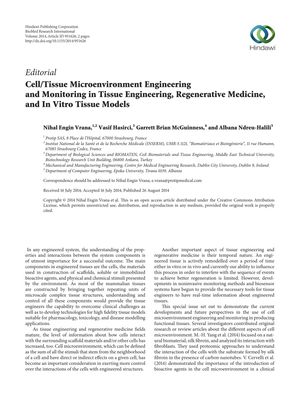Cell/Tissue Microenvironment Engineering and Monitoring in Tissue Engineering, Regenerative Medicine, and In Vitro Tissue Models
January 2014
in “
BioMed Research International
”

TLDR Engineering the cell microenvironment is key for advancing tissue engineering and regenerative medicine.
The document discusses the importance of understanding and controlling the cell microenvironment in tissue engineering and regenerative medicine. It highlights that as the fields have matured, knowledge about cell interactions with scaffolds and other cells has increased, emphasizing the significance of the cell microenvironment in controlling these interactions. The temporal nature of engineered tissues, which are remodeled over time, is also noted as a challenge, with current limitations in influencing this process for better regeneration. However, advancements in noninvasive monitoring methods and biosensor systems are providing tools for real-time information about engineered tissues. The special issue presented in the document showcases current developments and future perspectives in cell microenvironment engineering and monitoring, with contributions from various investigators. For instance, V. Cervelli et al. (2014) demonstrated the clinical application of bioactive agents in treating male pattern hair loss using platelet-rich plasma (PRP) injections, which resulted in a significant increase in hair density, epithelial thickness, and the number of hair follicles. The document concludes that engineering the cell microenvironment is crucial for future tissue engineering endeavors, including the development of organ-on-a-chip systems for pharmacological purposes.
